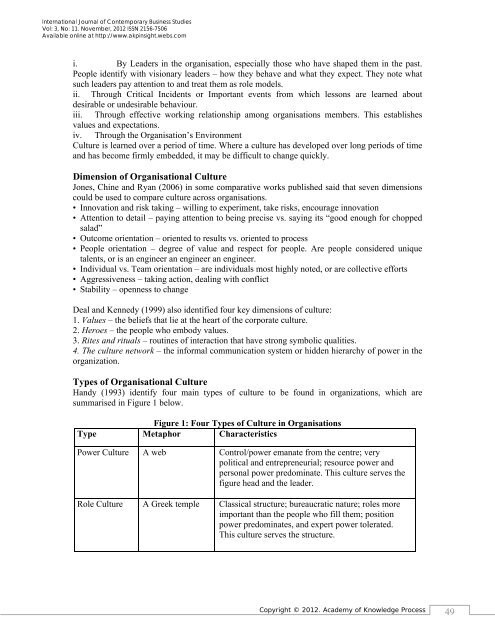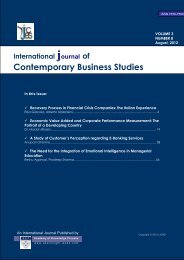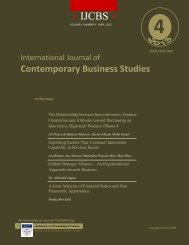International Journal of Contemporary Business Studies
International Journal of Contemporary Business Studies
International Journal of Contemporary Business Studies
You also want an ePaper? Increase the reach of your titles
YUMPU automatically turns print PDFs into web optimized ePapers that Google loves.
<strong>International</strong> <strong>Journal</strong> <strong>of</strong> <strong>Contemporary</strong> <strong>Business</strong> <strong>Studies</strong><br />
Vol: 3, No: 11. November, 2012 ISSN 2156-7506<br />
Available online at http://www.akpinsight.webs.com<br />
i. By Leaders in the organisation, especially those who have shaped them in the past.<br />
People identify with visionary leaders – how they behave and what they expect. They note what<br />
such leaders pay attention to and treat them as role models.<br />
ii. Through Critical Incidents or Important events from which lessons are learned about<br />
desirable or undesirable behaviour.<br />
iii. Through effective working relationship among organisations members. This establishes<br />
values and expectations.<br />
iv. Through the Organisation’s Environment<br />
Culture is learned over a period <strong>of</strong> time. Where a culture has developed over long periods <strong>of</strong> time<br />
and has become firmly embedded, it may be difficult to change quickly.<br />
Dimension <strong>of</strong> Organisational Culture<br />
Jones, Chine and Ryan (2006) in some comparative works published said that seven dimensions<br />
could be used to compare culture across organisations.<br />
• Innovation and risk taking – willing to experiment, take risks, encourage innovation<br />
• Attention to detail – paying attention to being precise vs. saying its “good enough for chopped<br />
salad”<br />
• Outcome orientation – oriented to results vs. oriented to process<br />
• People orientation – degree <strong>of</strong> value and respect for people. Are people considered unique<br />
talents, or is an engineer an engineer an engineer.<br />
• Individual vs. Team orientation – are individuals most highly noted, or are collective efforts<br />
• Aggressiveness – taking action, dealing with conflict<br />
• Stability – openness to change<br />
Deal and Kennedy (1999) also identified four key dimensions <strong>of</strong> culture:<br />
1. Values – the beliefs that lie at the heart <strong>of</strong> the corporate culture.<br />
2. Heroes – the people who embody values.<br />
3. Rites and rituals – routines <strong>of</strong> interaction that have strong symbolic qualities.<br />
4. The culture network – the informal communication system or hidden hierarchy <strong>of</strong> power in the<br />
organization.<br />
Types <strong>of</strong> Organisational Culture<br />
Handy (1993) identify four main types <strong>of</strong> culture to be found in organizations, which are<br />
summarised in Figure 1 below.<br />
Figure 1: Four Types <strong>of</strong> Culture in Organisations<br />
Type Metaphor Characteristics<br />
Power Culture A web Control/power emanate from the centre; very<br />
political and entrepreneurial; resource power and<br />
personal power predominate. This culture serves the<br />
figure head and the leader.<br />
Role Culture A Greek temple Classical structure; bureaucratic nature; roles more<br />
important than the people who fill them; position<br />
power predominates, and expert power tolerated.<br />
This culture serves the structure.<br />
Copyright © 2012. Academy <strong>of</strong> Knowledge Process<br />
49

















